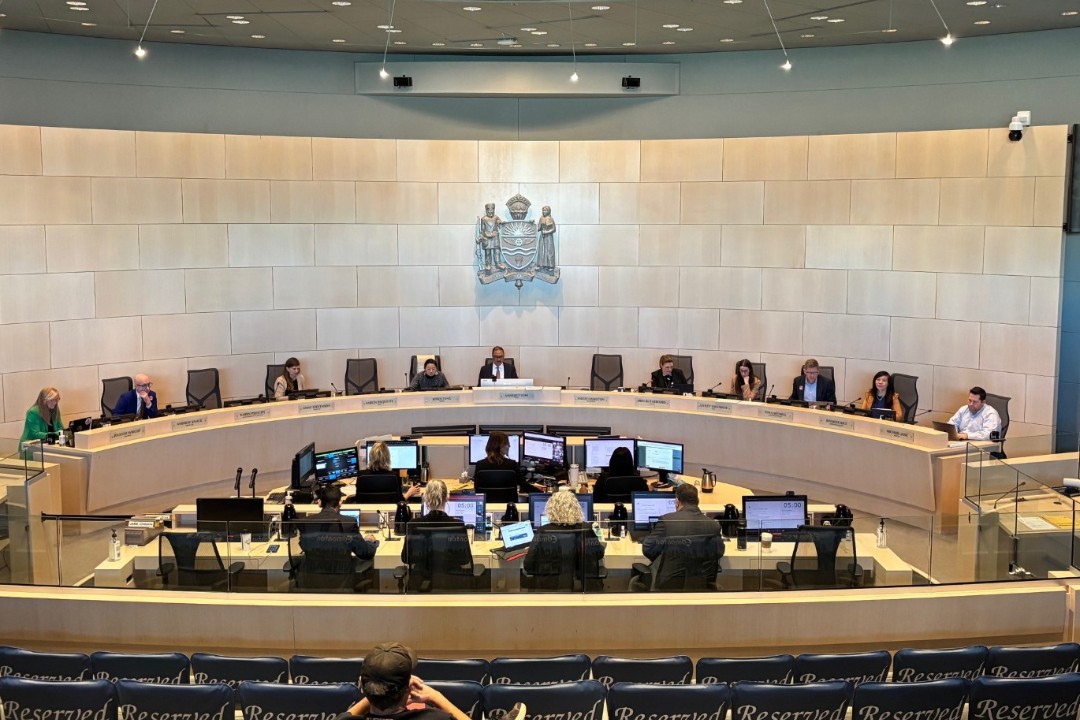
Vehicle traffic on 102 Avenue down 90% following LRT construction
A city report that offers insight into how the Valley Line LRT has changed the ways people move around the downtown core could lead to a review of wait times for pedestrian signals, adjustments to signage for drivers, and even even real-time warnings about cyclists.
The report, discussed at council's urban planning committee on Nov. 26, illustrates that vehicle traffic has decreased by 90% along 102 Avenue between 99 Street and 102 Street, parallel to the Valley Line LRT tracks, since the line was constructed and the street re-opened in 2023. On average, about 620 drivers used the street each day in June 2024, the month in which the most recent data was captured, compared to more than 6,270 before the LRT was built. Administration said this is likely because the design of the street is less appealing to drivers. The roadway is now one-way and left turns are prohibited along the full length from 99 Street to 102 Street. Drivers can't turn right on red, and must yield to cyclists when turning right. There are also no parking lots or curbside parking spots along the corridor.
The changes to traffic volumes and street design could have led to fewer collisions, administration said. Between 2015 and 2017, there were an average of about 17 collisions per year along the corridor. In 2023, the first full year 102 Avenue was open following LRT construction, there were seven collisions, with zero involving pedestrians or cyclists, the report said.
Pedestrian volumes, meanwhile, increased by 6% at 100 Street and 102 Avenue (beside the Stanley A. Milner Library) but decreased by as much as 50% at other intersections along the route compared to before the LRT was open and operating. The city said it doesn't have cyclist data from before the LRT was constructed, but that between 650 and 1,100 cyclists used the corridor daily in June 2024.
Administration found that 16% of people using the corridor broke the law while doing so. Pedestrians were responsible for the most common infractions but most created a low risk for collisions. More than a quarter of observed pedestrians broke the law, many by walking across 102 Avenue against a "do not walk" signal. About 18% of cyclists broke the law, with the most common infraction being a cyclist riding parallel to the LRT while the train had a signal to proceed but the signal was indicating for cyclists to stop. About 2% of drivers broke the law, many of whom blocked the intersection while avoiding stopping on the train tracks.
However, the city's numbers don't match what survey respondents reported they experienced along the corridor. Three out of four people who responded to a survey in June recorded unsafe experiences or near misses (where a collision was about to happen but was avoided by swerving or braking hard, for example). Some respondents said vehicle drivers often failed to yield when turning right across the bike lane and crosswalk, and others observed pedestrians walking against a "do not walk" signal. Survey respondents also said social disorder made them feel unsafe while using the corridor.
Council's urban planning committee heard from Max Amerongen, who bikes to work along the route and said the report did not give the whole picture. Amerongen installed a camera on his bike to record traffic violations along 102 Avenue, which captured drivers using the bike lane, driving the wrong way down the street, and turning right across the bike lane without yielding to cyclists and pedestrians. Amerongen said administration should learn from the observed near-misses to avoid more serious outcomes.
"The report you've got in front of you notes there's a moderate but significant degree of noncompliance by all types of road users, but the consequences of that can be so different," Amerongen said. "Someone looking both ways (and) crossing in a crosswalk after waiting two minutes for a signal is risking a ticket … but a driver turning right without signaling, looking, or yielding across a well-used bike lane is putting others in pretty serious danger. So let's not treat these behaviours as equivalent, and let's recognize drivers are causing severe danger, even if it's the design that's to blame."





